#spitalfields silk
Text

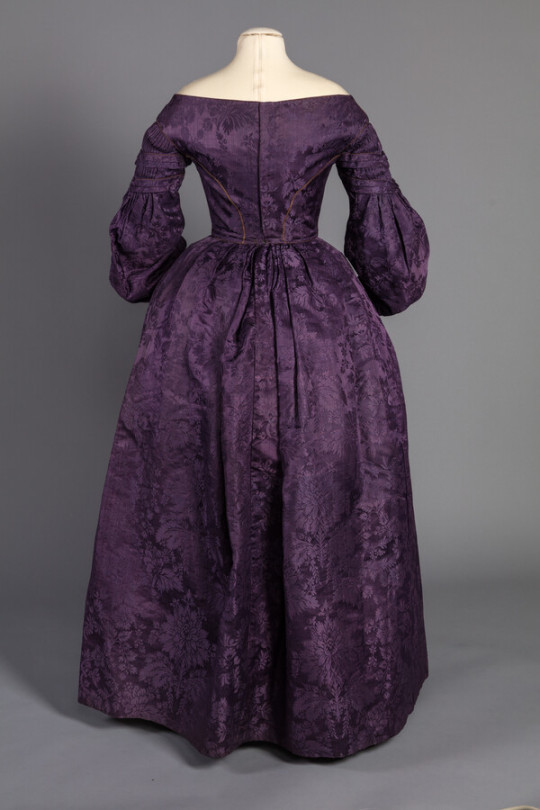
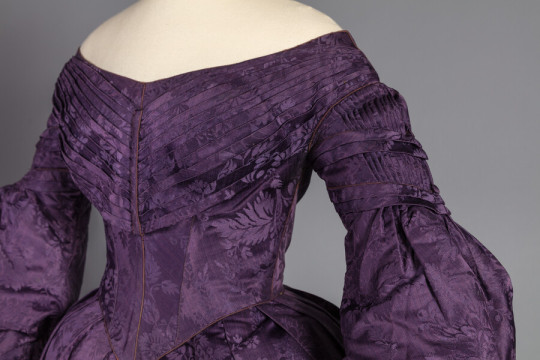
Oh, saints. This dress combines so many things I love in one place!
First of all, we’re in the late 1830s (by my guess), a time of dress transition. You can see the influence of the Romantic with those sleeves, but the hint of later Victorian gowns in the bodice shaping. The particular bodice here is fan-pleated, which is pretty self-explanatory if you look at the way the fabric is both pleated and fanned out. I do adore the result.
But, ahem, that damask? That color? Purple, always. Of course. For a 200 year old dress, the hue is still so striking. It is not Perkins Purple, however, as it’s two decades too early for that.
The weave? I damn near fell out of my chair looking at it. It’s one of those cases where I wish there were even higher resolutions so I could zoom in and see the stitches. Alas, we are not yet there in terms of technology, so I will instead cope with this.
And then it gets better. Because that silk damask? It’s almost 100 years older than the dress itself. UGH I LOVE IT SO MUCH. Could it have been Spitalfields? Maybe! It’s hard to say because we don’t have the provenance.
From the Maryland Center for History and Culture.
#silk dress#1830s#fashion history#textiles#costume history#historical costuming#history of fashion#costume#threadtalk#19th century fashion#historical fashion#spitalfields silk#damask
2K notes
·
View notes
Text
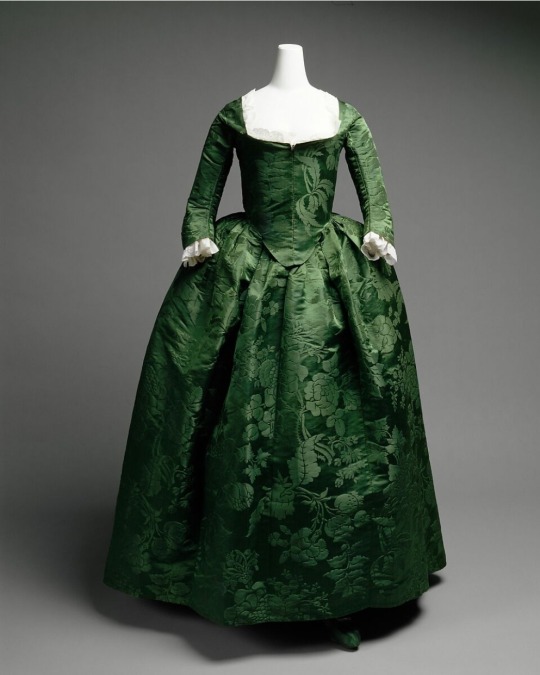
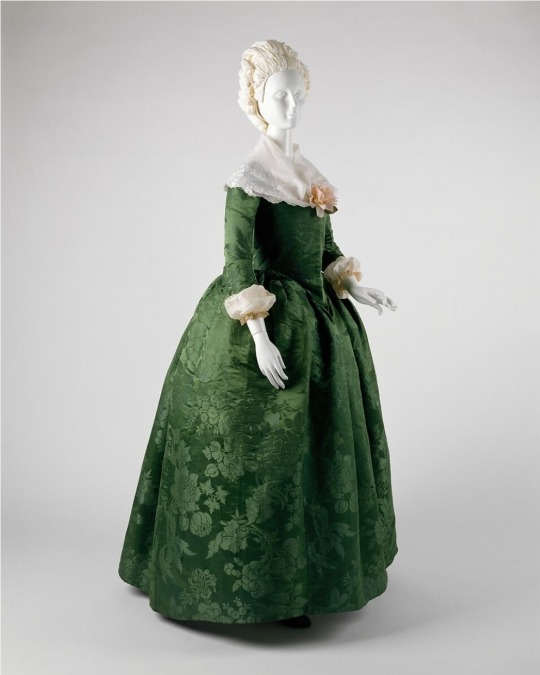
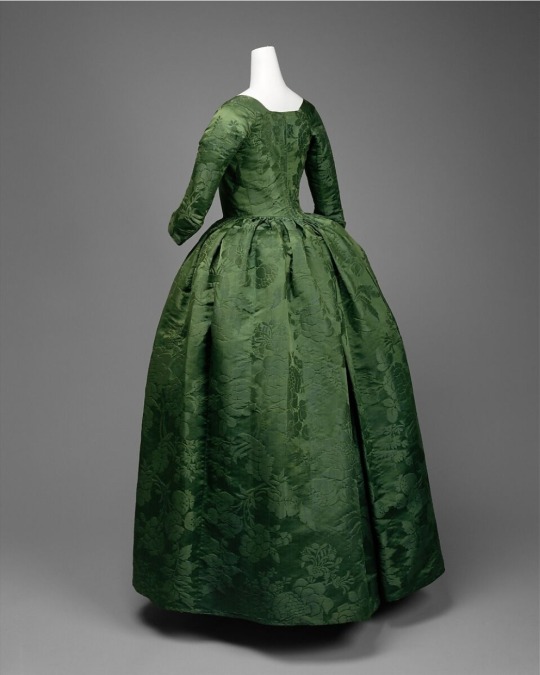

Title: Ensemble
Date: ca. 1775
Culture: American
Medium: silk
#18th century#18th century fashion#spitalfields silk#fashion history#historical fashion#silk#1770s fashion
663 notes
·
View notes
Photo


Detail from a piece of Spitalfields’ silk (circa 1750).
Silk and metal thread.
Images and text information courtesy The Met.
227 notes
·
View notes
Text


Beige Taffeta Dress, ca. 1830, American.
MFA Boston.
#womenswear#mfa boston#extant garments#silk#dress#taffeta#beige#usa#american#19th century#1830#1830s#1830s usa#1830s dress#spitalfields silk
106 notes
·
View notes
Text

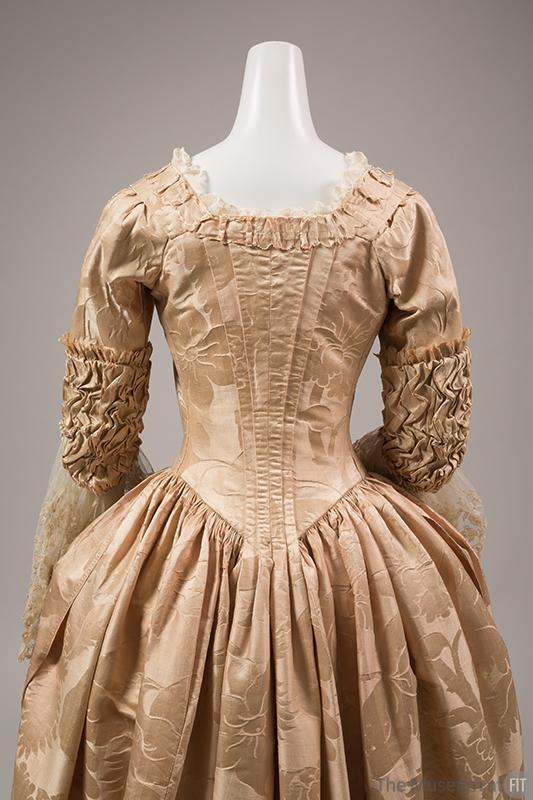
Silk damask robe a'langlaise. Spitalfields silk c.1735, dress c.1765.
via fashionmuseum.fitnyc.edu
#fashion history#history of fashion#historical fashion#history of dress#18th century#18th century fashion#robe a l'anglaise#spitalfields silk#1700s#1700s fashion#extant garments#pink#1730s#1760s#e
24 notes
·
View notes
Photo

Dennis Severs’ House
Not quite a museum, historic house, or art gallery, the house at 18 Folgate Street in Spitalfields is a bit of all three, yet at the same time quite undefinable and unique; the closest description is perhaps installation art, but even that fails to capture something that really has to be experienced to gain a full appreciation.

American artist Dennis Severs purchased the house in the late 1970s, at a time when Spitalfields was an unfashionable area, and the 10-room 18th Century property was relatively inexpensive. Severs reputedly moved in with a candle, a chamber pot, and a bedroll, and set about living in the house as he imagined its original inhabitants would have done. Sleeping in every room, he gradually began to give life to the imaginary Jervis family, Huguenot silk-weavers whose lives and fortunes formed the basis of the “still life drama” that visitors to the house would be able to explore.

Severs furnished each room with furniture, fittings and homeware purchased from local antique shops, creating a series of rooms each evoking a different period spanning the years 1724 to 1914, following the Jervis family from a prosperous Georgian era, through to the tough times of the Victorian age. The experience is more than just antiques though, as each room is filled with appropriate food and drink (put out fresh every day, one assumes), including half-eaten boiled eggs and toast, and glasses of various wines; fires and candles light the rooms at dusk and night, and in dark corners unpleasantly full chamber pots and mouldering items can be found lurking.

Accompanying these, sounds from inside and outside can be caught – whispered conversations from the house’s inhabitants, horses on the street, and distant tolling church bells. It all adds up to give the impression that the family have just left each room, with the visitor stepping into each scene. Guests are asked to remain silent during their visits, something Dennis Severs was known to enforce quite strictly before his death in 1999. As he said: “You either see it or you don’t”, and it would be hard to lose yourself in the experience listening to the chatter of other visitors…
#london#uk#england#dennis severs#house#spitalfields#art#historic house#museum#installation#still life#antique#antiques#furniture#fittings#homeware#Huguenot#Georgian#Victorian#silk weavers#food and drink#sounds#family#scene#silent#history#travel#tourism#lundene#londinium
37 notes
·
View notes
Text


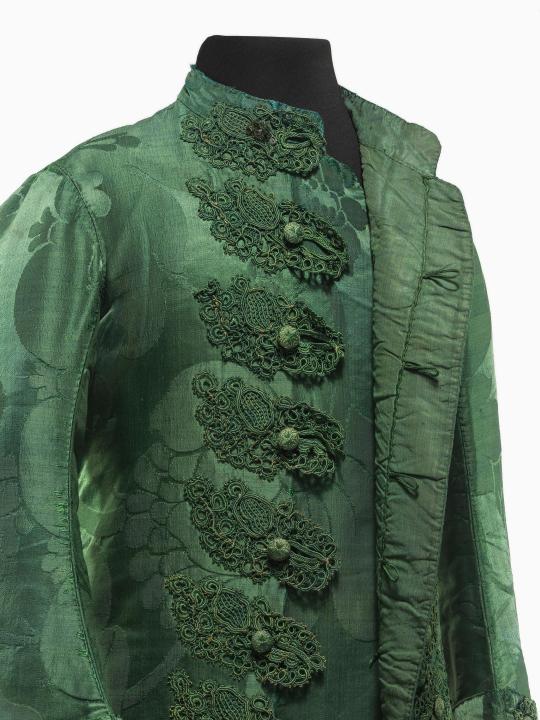


ab. 1760 Man's banyan (informal robe) (Spitalfields (London), England)
silk damask (figured silk in the style of Anna Maria Garthwaite)
(Royal Ontario Museum)
933 notes
·
View notes
Text
Melville himself apparently thought of Moby-Dick as a man's book and wrote to one of his female friends, Sara Moorehead, to dissuade her from reading it for fear of offending her feminine sensibilities: "Dont you buy it—dont even read it, when it does come out, because it is by no means the sort of book for you. It is not a piece of fine, feminine, Spitalfield silk—but is of the horrible texture of a fabric that should be woven of ship's cables and hausers.[2]" When Sophia Hawthorne wrote to Melville praising the book, his response was one of astonishment: "I have hunted up the finest Bath I could find, gilt-edged and stamped, whereon to inscribe my humble acknowledgment of your highly flattering letter of the 29th of Dec:—It really amazed me that you should find any satisfaction in that book. It is true that some men have said they were pleased with it but you are the only woman—for as a general thing, women have small taste for the sea.[3]" "Next time," Melville tells Sophia, he shall not send her a "bowl of salt water. . . . The next chalice I shall commend, will be a rural bowl of milk." He then inquires politely about the state of her "domestic affairs."[4] Melville's remarks to these women suggest that he was working under certain gender-determined notions of genre.
Content warning: This book contains the horrible texture of a fabric that should be woven of ship's cables and hausers.
I don't think it's just something period-typical because it implies it now isn't, gender-determined notions of genre are still a thing around the world.
I do feel that in Moorehead's place, I'd have gone WELL NOW I'M GONNA. It's funny to me that in general the boys in my American Literature class would comment things like how it's mostly boring (you don't get it) or about how this is about the national identity of a young country, meanwhile girls would pipe in about multiple facets.
Amerilit girlies: I have so much to say about Moby Dick!
Herman: absolutely flabbergasted
#Melville and the Woman's Story#I haven't read the rest of the paper yet#moby dick#herman melville#whale weekly#van helsing moment#the whale weekly
850 notes
·
View notes
Text

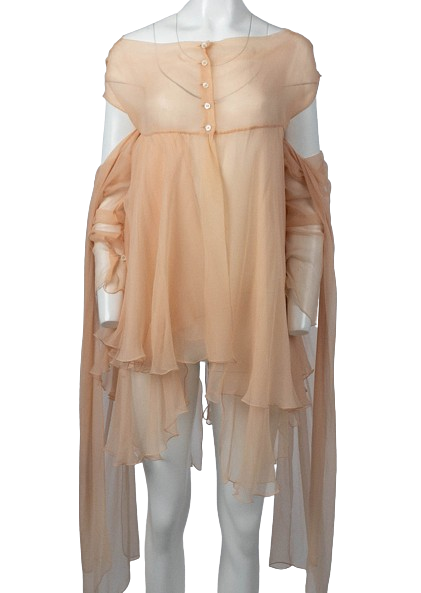



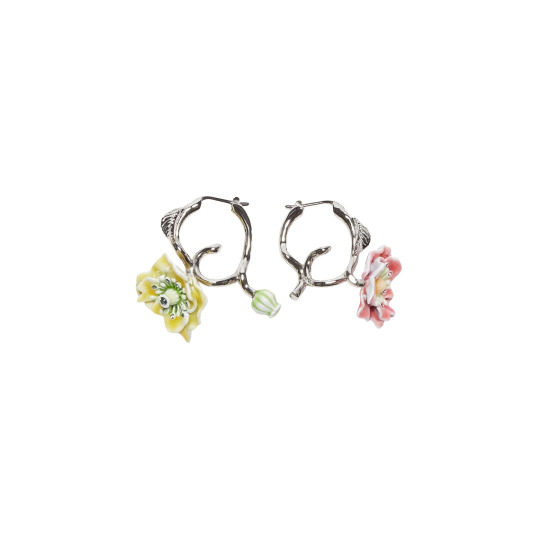
"spring outfit inspired by ophelia floating in the river among the flowers", requested by @katabasiskassandra .
dolce & gabbana peach silk babydoll-style dress w/ empire-line bodice and ethereal petal-like layers, s/s 1991
romeo gigli flower-filled chiffon deep-shawl-collared coat, c. 199o
pavilion parade "moll flanders" loungers, created from a small fragment of antique 18th century spitalfields silk brocade
victorian-era floral bridal crown w/ silk, glass, feathers, and pink ribbons
acne studios flower hoop earrings
#ophelia#spring#floral#katabasiskassandra#outfit#hope you like !#request#dolce & gabbana#199o's#vintage#antique#romeo gigli#pink#peach#green#yellow#pavilion parade#footwear#victorian#crown#headpiece#ribbons#coat#acne studios#earrings#jewellry#queue
144 notes
·
View notes
Text
Spitalfields Silk Dress
Unidentified maker; fabric designed by Anna Maria Garthwaite and woven by Mr. Pulley, Spitalfields, England
Date: 1742-1743; altered c. 1840
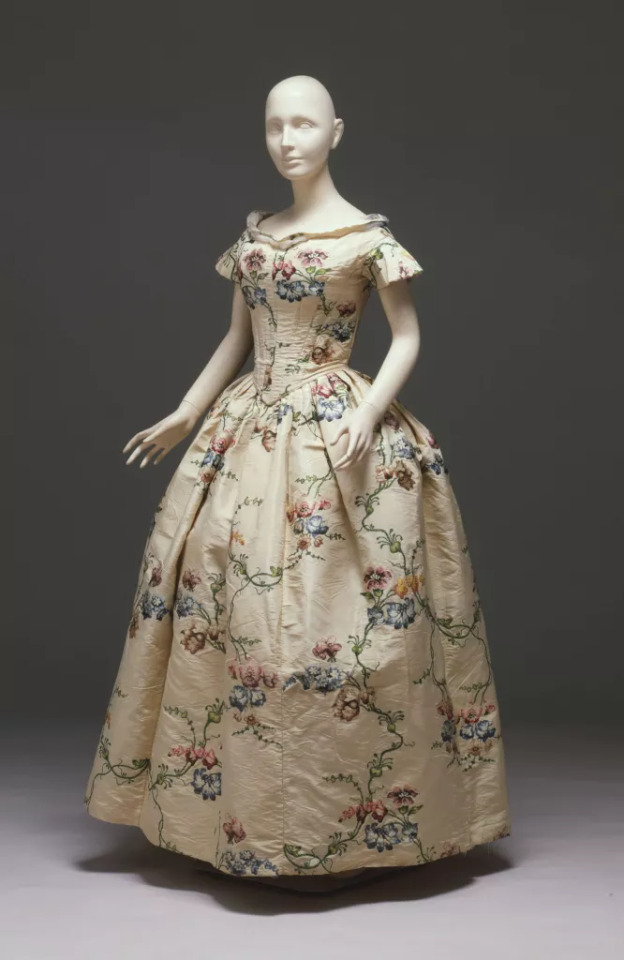
Comment: Only four pieces of fabric were usually woven of any one pattern, so that the fashion-conscious gentry who wore these elaborate dresses would never see anyone else wearing something similar. This dress was made of English fabric, probably for Christina Ten Broeck Livingston, wife of Philip Livingston, a signer of the Declaration of Independence. It may have been worn at the christening of Christina's son Dirck in 1743. The fabric in this dress shows the beginnings of the naturalistic Rococo style in English silks.
Albany Institute of History and Art
133 notes
·
View notes
Text
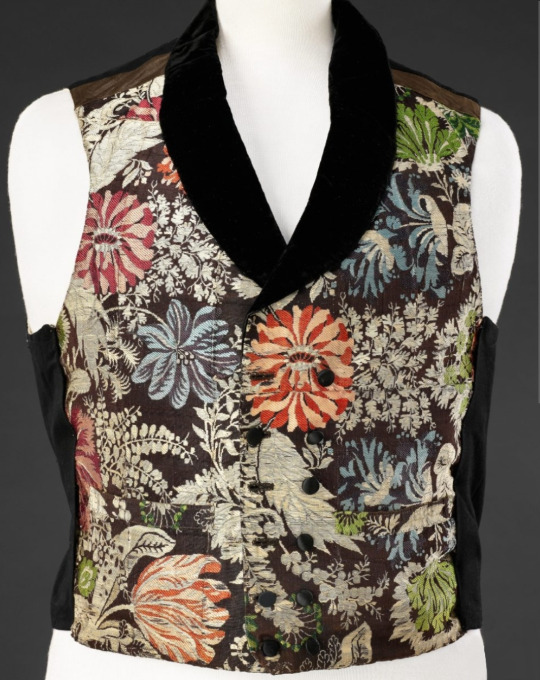
An 1840s men's waistcoat in silk and velvet from the John Bright Collection, made from reused 18th century silk probably woven in the late 1720s or early 1730s at Spitalfields:
Surviving examples of 18th Century figured silks with black grounds are uncommon, the chemicals used in the dying and mordanting process (which could be lengthy to achieve a deep black) tending to weaken the fibres, causing them to deteriorate with time.
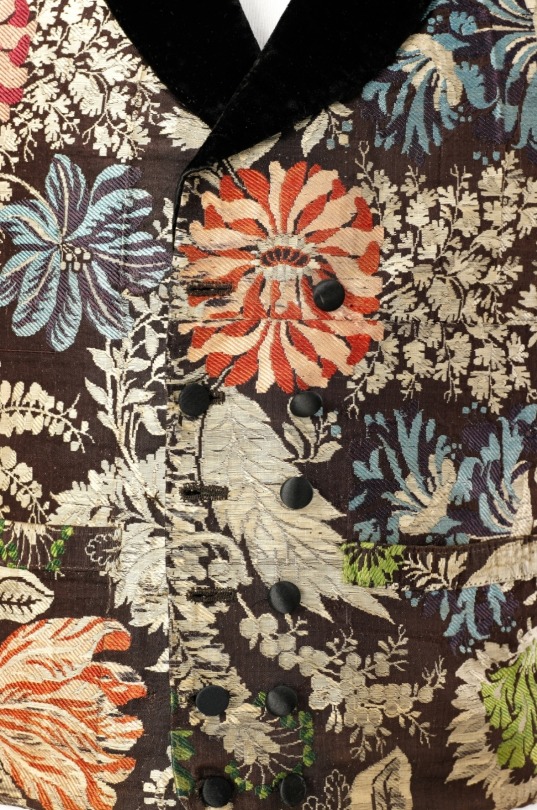
Between the loud, colourful pattern and the Early Victorian love of historical clothing, I imagine that the man who wore this was very proud of it!

An illustration by Archibald Henning for The Natural History of Humbugs (1847)
#Eighteen-Forties Friday#1840s#fashion history#textiles#silk#early victorian era#historical men's fashion#men's fashion#fashion#extant#archibald henning#dress history#waistcoat
83 notes
·
View notes
Text


No, you are not imagining things. This is not a Betsey Johnson dress somehow masquerading as a historical garment. There was no time travel. This is a real gown from the mid(ish) 1700s made of Spitalfields silk.
Like many extant gowns, the secret is in the stitching. We know a few things about this dress due to its construction. 1) it was remade to fit changing aesthetics, likely during the same century and 2) it's a selvedge dress, meaning that unlike mantuas, it's made of pieced together silk (most expertly done) to show the appearance of an undisturbed piece of fabric.
The bright, floral brocade pattern is not at all uncommon, as the motifs of this era were certainly vivid in every sense. I particularly love the contrasting deep brown of the stomacher with the rest of the dress. It's relatively simple in terms of the times, but I adore it!
From Cora Ginsburg.
#baroque#history of fashion#threadtalk#textiles#costume history#historical costuming#costume#fashion history#silk dress#spitalfields#brocade
2K notes
·
View notes
Text
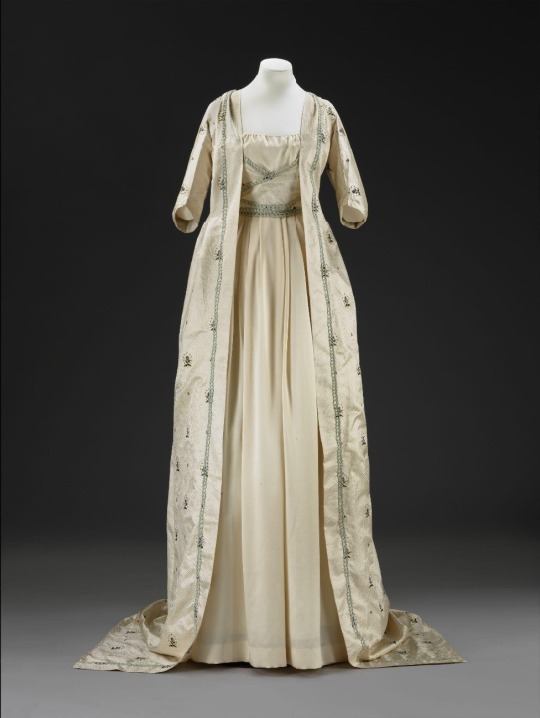



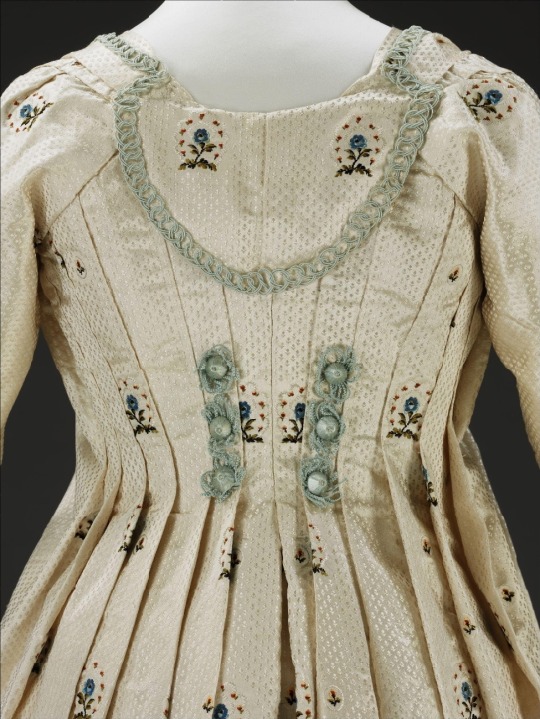
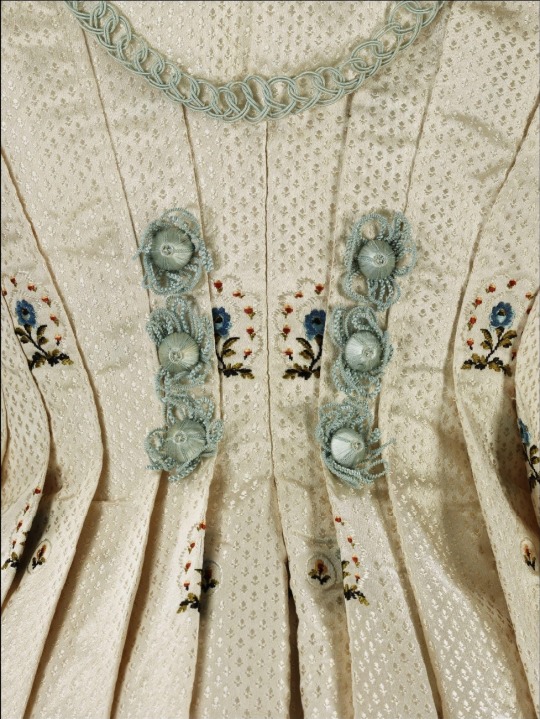


Woman's gown, English, 1790-1795, cream figured silk brocaded with blue flowers, 1780-89, Spitalfields; trimmed with eau-de-nil silk gimp
#18th century#18th century fashion#spitalfields silk#fashion history#historical fashion#1790s#1790s fashion#regency#regency fashion
727 notes
·
View notes
Photo

Spitalfields brocade dress (American, circa 1840).
Silk brocade and silk satin with cotton lining.
Image and text information courtesy MFA Boston.
381 notes
·
View notes
Text

Brown Floral Embroidered Waistcoat, ca. 1734, British.
Victoria and Albert Museum.
#brown#menswear#1734#1730s#18th century#spitalfields silk#silk#waistcoat#1730s menswear#1730s waistcoat#1730s britain#extant garments#embroidery#floral#V&A
25 notes
·
View notes
Text
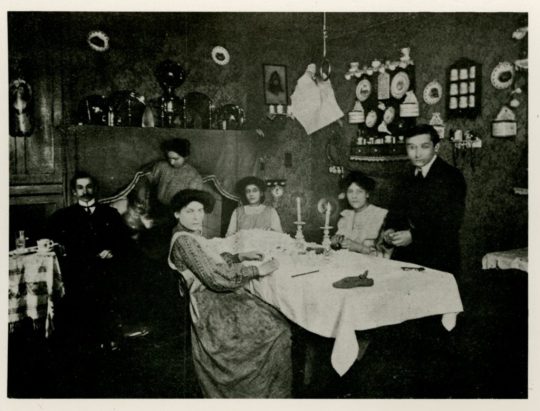
'The Chuts'. Dutch Cigar Makers’ Sabbath meal in London's East End, 19th century • Sandys Row Archive
From the 1840s onwards a small group of pioneering Dutch Jews (about 50 families), mainly from Amsterdam, settled in an area in West Spitalfields known as the Tenterground. Hugeunot silk weavers, erected homes and workshops there in the eighteenth century, later becoming occupied by this small tight-knit Dutch immigrant Jewish community, known as “the Chuts.” These little known Dutch Jewish immigrants pre-date the mass migration of Ashkenazi Jewish migrants who fled persecution in the Pale of Settlements and arrived in their thousands to the area from 1880s onwards. The Dutch immigrants who established Sandys Row Synagogue were economic migrants seeking a better life, rather than refugees fleeing persecution. They had their own practises and customs, which were different to other Ashkenazi Jewish groups and refused to join any of the existing synagogues. Most of the newly arrived Dutch Jews were skilled workers, predominately involved in the trades of cigar and cigarette making, diamond cutting and polishing, slipper and cap making. Skills were passed on from generation to generation, making this small community of about a thousand people extremely self sufficient.
53 notes
·
View notes